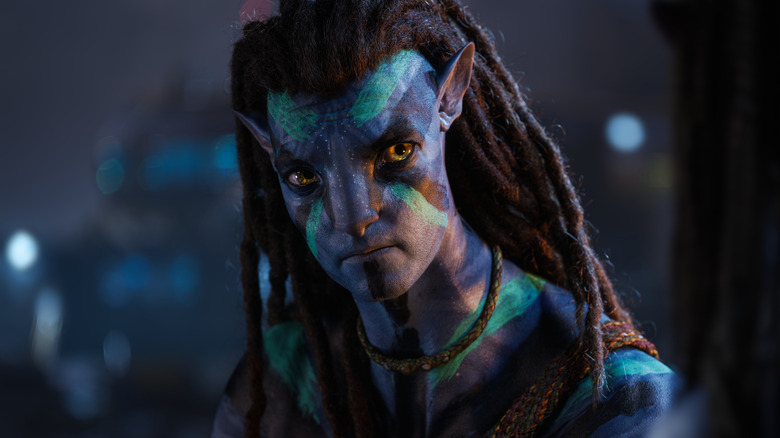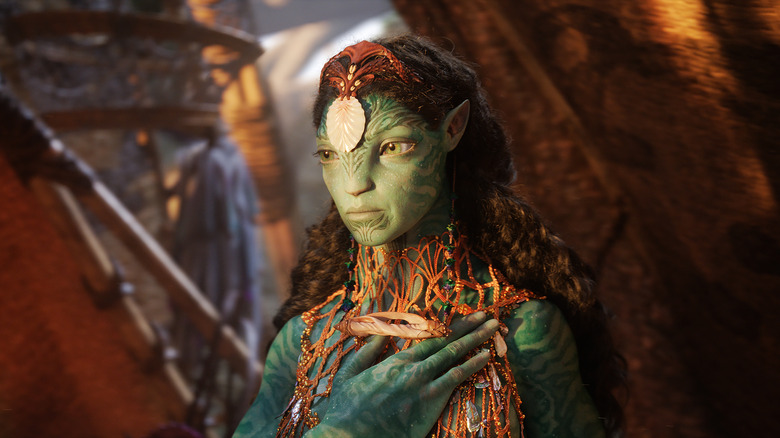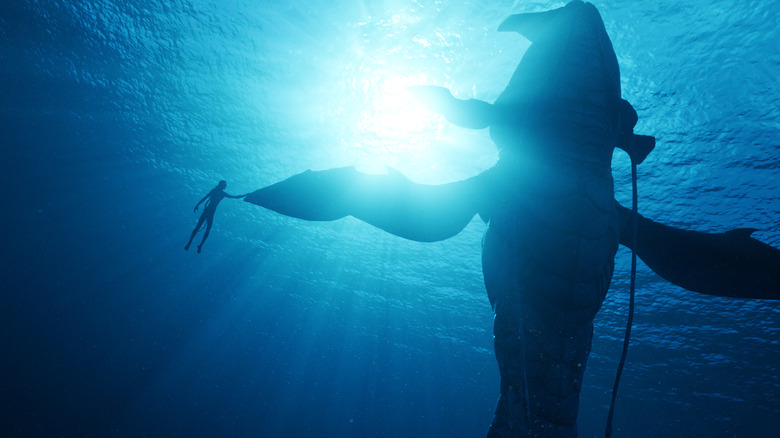How Creating The Visual Effects For Avatar: The Way Of Water Differed From The First Film
Back in 2009, "Avatar" was an incredible step forward in the realm of visual effects. The fidelity and imagination James Cameron put into creating the world of Pandora and the Na'vi made some audience members never want to leave the theater. In the 13 years since its release, visual effects as an artform has been trying to replicate that magic, and while there have been indisputable improvements in technology, almost no film since then has matched the imagination of "Avatar."
"Avatar: The Way of Water" takes things to a whole new level. Obviously, technological advancements have aided the movie's breathtaking visuals, but technology can only get you so far in creating sequences you can't believe you're seeing on screen. Determining how good an effect is isn't simply assessing how realistic it looks, which is where tech really helps — truly great effects involve artistry, specifically around how they are composed within the frame of the movie.
This artistry is what made the first film so successful, and the effects artists working on "The Way of Water" knew they had an invaluable resource in Cameron's 2009 mammoth blockbuster. To that end, the creative team used the language established in "Avatar" to push the sequel into the modern era of VFX.
The fundamentals of filmmaking, but virtual
Too many people get caught up in whether or not a visual effect looks real instead of whether or not it's cinematic. Visual effects artists, however, are just that: Artists. They are constructing and animating things to serve a greater artistic purpose — it's not about whether the images look real (though "Avatar: The Way of Water" certainly succeeds in that area), but how they enhance the mise en scène. At a press conference attended by /Film, Wayne Stables — a Weta Digital VFX supervisor who oversaw the movie's jungle scenes — expressed his team's desire to build upon the filmmaking principles of the first film:
"I was interested in how our lighting and our camera models had improved over all that time, so that we could just, once again, deliver a lot more plausible images that felt like cinematography, which I think was a really big thing that we wanted to do on this film, just to try and lift that. In some ways, we tried to lift everything on this film. And we do. We always strive to lift stuff as much as we can. We lift it in the performance and the design. And I wanted to lift it in terms of what the final image quality looked like."
"The Way of Water" was shot in entirely digitally created environments, including the camera and lighting, which allowed Stables and his team to take a cinematographic approach to their work. This allowed the visual effects and the cinematography to have a symbiotic relationship, where one could not exist without the other.
Finding the complimentary look underwater
Though the desire of the sequel was to visually enhance the original movie, "The Way of Water" does have a major visual difference this time around, and it's right there in the title. Obviously, if the underwater parts of this film looked identical to the first movie's jungle sequences, it would look rather odd. On "The Way of Water," the effects artists were tasked with finding a bridge that could connect the jungle and the water. Pavani Bodapatti — Weta Digital's VFX supervisor of the Metkayina Village and the reefs they inhabit — talked about how they found their underwater look:
"So, we always reference the first move for the aesthetic and the visual look, right? We looked at all the jungle shots in the first movie. We looked at the color composition, how the things are put together. And we applied all of those things, except it's under the water now. So, you have another layer on top, which is the water. You have the absorption and the look of the water, but we really built up on what we learned in the first film."
The end results are staggering. Exploring this new environment in "The Way of Water" gave me the same thrill as discovering Pandora for the first time, but to an even greater degree. The visual effects team wildly succeeded in their desire to harness that same magic from the original "Avatar" and brought the imagery to even new heights.


